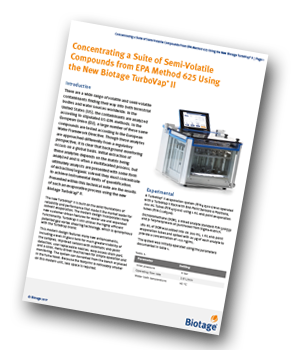Biotage has produced an application note in which fifty semi-volatile compounds were concentrated using the new TurboVap® II evaporator according to the EPA Method 625. For each of them, six replicates were done to assess the analyte recovery and the relative standard deviation (RSD) at a fixed versus ramped flow.
 Introduction
Introduction
There are a wide range of volatile and semi-volatile contaminants finding their way into both terrestrial bodies and water sources worldwide. In the United States (US), the contaminants are analysed according to stipulated US-EPA methods. In the European Union (EU), a large number of these same compounds are tested according to the European Water Framework Directive. Though these analytes are approached differently from a regulatory perspective, it is clear that background monitoring occurs on a global basis. Initial extraction of these analytes depends on the matrix being analysed and is often a multifaceted process, but ultimately analysts are presented with some form of extraction/organic solvent that they must concentrate to achieve instrumental limits of quantification. Presented within this technical note are the results of such an evaporative process using the new Biotage TurboVap® II.
Experimental
A TurboVap® II evaporation system (P/N 415001) was operated with a TurboVap II Rack with End-Point Sensors 6 Positions, 200 mL Tubes (P/N 415100) using 1 mL end-point evaporation tubes (P/N C128506).
Dichloromethane (DCM), a mixed analyte standard P/N 506559 and p-Terphenyl were all purchased from Sigma-Aldrich. 180 mL of DCM was added into six 200 mL, 1 mL end-point evaporation tubes and spiked with 20 μg of each analyte to provide a concentration of ~111 ng/mL.
Analysis
Gas chromatography-mass spectrometry (GC-MS) was used for the quantitative determination of each analyte following evaporation.
Results
A total of n=6 replicates for each of the two evaporation methods were analysed and the averages are
presented. Recovery and RSD values were calculated by comparing the peak area response of p-Terphenyl in a standard and the processed samples and generating an RF. This RF was then used to volumetrically normalize the results for the processed samples when compared to the standard.
Conclusion
The new TurboVap® II evaporation system is shown to provide excellent recoveries and RSDs for a wide range of semi-volatile compounds. With two options available for tube sizes 50 or 200 mL and either 0.5 or 1.0 mL end-point, the system can be used with solvent extracts derived from a wide range of extraction methodologies, including solid-phase extraction, supported liquid extraction, liquid-liquid extraction,
continuous liquid-liquid extraction, TLCP extracts, pressurized fluid extraction, and ultrasonic extraction.




